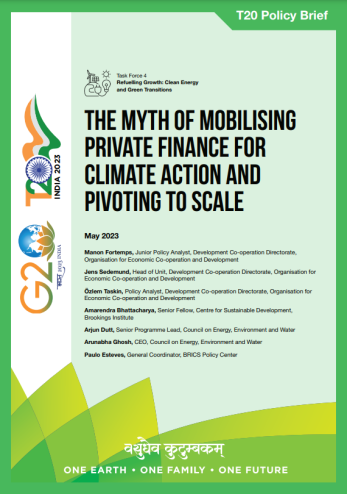Report
Common Risk Mitigation Mechanism
Feasibility Study
CEEW
November 2017 | Sustainable Finance
Citation: Council on Energy, Environment and Water, Confederation of Indian Industry, The Currency Exchange Fund, and Terrawatt Initiative. 2017. Common Risk Mitigation Mechanism Feasibility Report. New Delhi: Council on Energy, Environment and Water.
Overview
This feasibility report on the Common Risk Mitigation Mechanism (CRMM) has been driven by governments of 17 nations with strong solar potential as a way for scaling investments in solar power generation in their countries and in other developing countries. In May 2017, these nations mandated a multi-stakeholder Taskforce consisting of the Council on Energy, Environment and Water (CEEW), the Terrawatt Initiative, The Currency Exchange Fund (TCX), and the Confederation of Indian Industry (CII), to conduct a study on the feasibility of implementing CRMM, including broad based consultation with relevant stakeholders.
The study is in line with the framework of the International Solar Alliance (ISA), and specifically addresses its mandate to aggregate and harmonize frameworks for investment. In particular, this study aims to operationalise ISA's programme for ‘Affordable Finance at Scale,’ initiated by both India and France.
The study outlines the economic, legal, and operational feasibility conditions for the successful implementation of the Common Risk Mitigation Mechanism. It was released at COP23 in Bonn in November 2017.

Broken Hill solar park in New South Wales, Australia (Source: Wikimedia Commons)
Key Findings
The study is based on the following findings of the Taskforce
- Financing of solar power generation assets in the majority of developing countries suffers from inadequate availability of risk management tools, a high perception of risk, high transaction costs, small project sizes (granularity) and lack of scale.
- Investors, developers, and other stakeholders require transparency and clarity of process – which in some countries often is missing.
- The international development community and private commercial financiers are eager to participate in the creation of a global solar market.
- Development Finance Institutions have created a successful track record in leveraging private sector capital through risk mitigation mechanisms, and are now seeking to scale-up this leveraging to even larger levels under the theme of “billions to trillions”, including mainstream deployment of local capital and savings.
- Private and institutional capital markets have successfully deployed green bonds and innovative structures for securitising receivables from various sources, including renewable power investments.
All the ingredients for expanding access to affordable solar energy in developing countries already exist. These efforts could accelerate more rapidly for the benefit a large number of countries, if they are conducted in a coordinated manner at scale, and within a common platform.
Key Recommendations
The Taskforce has presented the following recommendations for formulating and implementing the Common Risk Mitigation Mechanism:
- Develop an easily accessible first demand financial guarantee instrument (comprising a bundle of different risk management instruments ranging from guarantees, insurance, to swaps, which will cover risks in both local currencies and hard currencies) intended to provide private institutional investors (investors) in Solar PV investments in developing countries with a high level of security against (i) the risks of currency exchange, (ii) the risks of transfers and inconvertibility, (iii) the risks of electricity purchasing counterparties, and (iv) the political risks (together the Guaranteed Risks) while crowding-in existing specialized instruments for risk mitigation.
- Establish a Guarantor Entity benefiting from a strong investment grade credit rating, and which is well capitalized by public and private funds (including from States, Development Finance Institutions and any other public or private investor wishing to participate) with cash, lines of credit and sovereign guarantees.
- Establish an independent company which operates a digital platform with a management mandate from the Guarantor Entity.
- Launch a pilot project in 2018, which will be completed within 3-5 years from inception. The aim of the pilot is to achieve a critical size and demonstrate its cost effectiveness in pooling and aggregating capital, and mitigating risks at an international level. Its progressive deployment will target an ultimate USD 1 billion Guaranteed Entity capitalization and an underlying asset portfolio of approximately USD 15 billion in some twenty volunteer countries by the end of the Pilot Project. Simulations in median scenarios demonstrate limited requirement for the capitalisation of the Guarantee during the first 2 years.
- Designate a multi-stakeholder working group to prepare a detailed project implementation plan and implement it within 9 to 15 months.

The Charanka solar park in Patan, Gujarat (Source: Wikimedia Commons)






